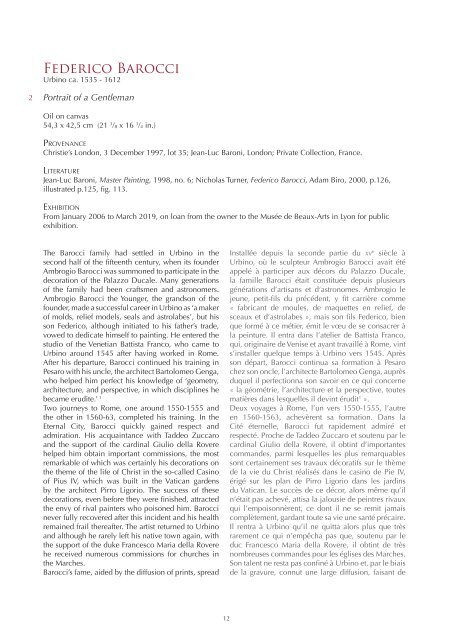XVII - Master Paintings - Jean Luc Baroni and Marty de Cambiaire
You also want an ePaper? Increase the reach of your titles
YUMPU automatically turns print PDFs into web optimized ePapers that Google loves.
Fe<strong>de</strong>rico Barocci<br />
Urbino ca. 1535 - 1612<br />
2<br />
Portrait of a Gentleman<br />
Oil on canvas<br />
54,3 x 42,5 cm (21 3 /8 x 16 3 /4 in.)<br />
Provenance<br />
Christie’s London, 3 December 1997, lot 35; <strong>Jean</strong>-<strong>Luc</strong> <strong>Baroni</strong>, London; Private Collection, France.<br />
Literature<br />
<strong>Jean</strong>-<strong>Luc</strong> <strong>Baroni</strong>, <strong>Master</strong> Painting, 1998, no. 6; Nicholas Turner, Fe<strong>de</strong>rico Barocci, Adam Biro, 2000, p.126,<br />
illustrated p.125, fig. 113.<br />
Exhibition<br />
From January 2006 to March 2019, on loan from the owner to the Musée <strong>de</strong> Beaux-Arts in Lyon for public<br />
exhibition.<br />
The Barocci family had settled in Urbino in the<br />
second half of the fifteenth century, when its foun<strong>de</strong>r<br />
Ambrogio Barocci was summoned to participate in the<br />
<strong>de</strong>coration of the Palazzo Ducale. Many generations<br />
of the family had been craftsmen <strong>and</strong> astronomers.<br />
Ambrogio Barocci the Younger, the gr<strong>and</strong>son of the<br />
foun<strong>de</strong>r, ma<strong>de</strong> a successful career in Urbino as ‘a maker<br />
of molds, relief mo<strong>de</strong>ls, seals <strong>and</strong> astrolabes’, but his<br />
son Fe<strong>de</strong>rico, although initiated to his father’s tra<strong>de</strong>,<br />
vowed to <strong>de</strong>dicate himself to painting. He entered the<br />
studio of the Venetian Battista Franco, who came to<br />
Urbino around 1545 after having worked in Rome.<br />
After his <strong>de</strong>parture, Barocci continued his training in<br />
Pesaro with his uncle, the architect Bartolomeo Genga,<br />
who helped him perfect his knowledge of ‘geometry,<br />
architecture, <strong>and</strong> perspective, in which disciplines he<br />
became erudite.’ 1<br />
Two journeys to Rome, one around 1550-1555 <strong>and</strong><br />
the other in 1560-63, completed his training. In the<br />
Eternal City, Barocci quickly gained respect <strong>and</strong><br />
admiration. His acquaintance with Tad<strong>de</strong>o Zuccaro<br />
<strong>and</strong> the support of the cardinal Giulio <strong>de</strong>lla Rovere<br />
helped him obtain important commissions, the most<br />
remarkable of which was certainly his <strong>de</strong>corations on<br />
the theme of the life of Christ in the so-called Casino<br />
of Pius IV, which was built in the Vatican gar<strong>de</strong>ns<br />
by the architect Pirro Ligorio. The success of these<br />
<strong>de</strong>corations, even before they were finished, attracted<br />
the envy of rival painters who poisoned him. Barocci<br />
never fully recovered after this inci<strong>de</strong>nt <strong>and</strong> his health<br />
remained frail thereafter. The artist returned to Urbino<br />
<strong>and</strong> although he rarely left his native town again, with<br />
the support of the duke Francesco Maria <strong>de</strong>lla Rovere<br />
he received numerous commissions for churches in<br />
the Marches.<br />
Barocci’s fame, ai<strong>de</strong>d by the diffusion of prints, spread<br />
Installée <strong>de</strong>puis la secon<strong>de</strong> partie du xv e siècle à<br />
Urbino, où le sculpteur Ambrogio Barocci avait été<br />
appelé à participer aux décors du Palazzo Ducale,<br />
la famille Barocci était constituée <strong>de</strong>puis plusieurs<br />
générations d’artisans et d‘astronomes. Ambrogio le<br />
jeune, petit-fils du précé<strong>de</strong>nt, y fit carrière comme<br />
« fabricant <strong>de</strong> moules, <strong>de</strong> maquettes en relief, <strong>de</strong><br />
sceaux et d’astrolabes », mais son fils Fe<strong>de</strong>rico, bien<br />
que formé à ce métier, émit le vœu <strong>de</strong> se consacrer à<br />
la peinture. Il entra dans l’atelier <strong>de</strong> Battista Franco,<br />
qui, originaire <strong>de</strong> Venise et ayant travaillé à Rome, vint<br />
s’installer quelque temps à Urbino vers 1545. Après<br />
son départ, Barocci continua sa formation à Pesaro<br />
chez son oncle, l’architecte Bartolomeo Genga, auprès<br />
duquel il perfectionna son savoir en ce qui concerne<br />
« la géométrie, l’architecture et la perspective, toutes<br />
matières dans lesquelles il <strong>de</strong>vint érudit 1 ».<br />
Deux voyages à Rome, l’un vers 1550-1555, l’autre<br />
en 1560-1563, achevèrent sa formation. Dans la<br />
Cité éternelle, Barocci fut rapi<strong>de</strong>ment admiré et<br />
respecté. Proche <strong>de</strong> Tad<strong>de</strong>o Zuccaro et soutenu par le<br />
cardinal Giulio <strong>de</strong>lla Rovere, il obtint d’importantes<br />
comm<strong>and</strong>es, parmi lesquelles les plus remarquables<br />
sont certainement ses travaux décoratifs sur le thème<br />
<strong>de</strong> la vie du Christ réalisés dans le casino <strong>de</strong> Pie IV,<br />
érigé sur les plan <strong>de</strong> Pirro Ligorio dans les jardins<br />
du Vatican. Le succès <strong>de</strong> ce décor, alors même qu’il<br />
n’était pas achevé, attisa la jalousie <strong>de</strong> peintres rivaux<br />
qui l’empoisonnèrent, ce dont il ne se remit jamais<br />
complètement, gardant toute sa vie une santé précaire.<br />
Il rentra à Urbino qu’il ne quitta alors plus que très<br />
rarement ce qui n’empêcha pas que, soutenu par le<br />
duc Francesco Maria <strong>de</strong>lla Rovere, il obtint <strong>de</strong> très<br />
nombreuses comm<strong>and</strong>es pour les églises <strong>de</strong>s Marches.<br />
Son talent ne resta pas confiné à Urbino et, par le biais<br />
<strong>de</strong> la gravure, connut une large diffusion, faisant <strong>de</strong><br />
12















